An Archaeological Challenge: The Conservation and Restoration of Luxury Roman Glass from Troia, Portugal
Abstract
1. Introduction
1.1. Troia Site and Glass Set
1.2. Challenges of Treating Archaeological Glass
2. Treatment Preparation and Working Phases
2.1. Training Workshop
2.2. Cleaning
2.3. Consolidation and Assembly of Fragments
2.3.1. Preparing and Using Paraloid B-72 as an Adhesive
2.3.2. Adhesive Application Strategy
2.4. Building 3D Support Structures in Borosilicate Glass Lampworking Technique
3. Conclusions and Future Perspectives
Author Contributions
Funding
Data Availability Statement
Acknowledgments
Conflicts of Interest
Abbreviations
| VICARTE | Research and Development Unit ‘Glass and Ceramics for the Arts’ |
| DCR | Department of Conservation and Restoration from NOVA School of Science and Technology |
| PB-72 | Paraloid B-72 |
| 1 | Free translation to English by the authors. |
References
- Römich, H. Historic glass and its Interaction with the Environment. In The Conservation of Glass and Ceramics: Research, Practice and Training; Tennent, N., Ed.; James and James: London, UK, 1999; pp. 5–14. [Google Scholar]
- Koob, S.P. Conservation and Care of Glass Objects; Corning: Archetype Publication & The Corning Museum of Glass: New York, NY, USA, 2006. [Google Scholar]
- Pereira, A.; Vilarigues, M.; Coutinho, I. Archaeological glass conservation and restoration intervention materials–A literature review. Conserv. Património 2021, 39, 96–113. [Google Scholar] [CrossRef]
- Oddy, A.; Carroll, S. (Eds.) Opacity Contrariwise. In Reversibility-Does It Exist? Occasional paper (British Museum); No. 135; British Museum: London, UK, 1999; pp. 135–140. [Google Scholar]
- Celorico, M.; Ferreira, J.L.; Celorico, M.I.; Ferreira, J.L.; Coutinho, I. The Color Effect of Orasol Dyes in Epoxy Resins Hxtal NYL-1 and Araldite 2020 for Glass and Ceramics Conservation. Available online: https://www.researchgate.net/publication/325430357 (accessed on 4 May 2025).
- Coutinho, I.; Ramos, A.M.; Lima, A.M.; Feinandes, F.B. Studies on degradation of epoxy resins used for conservation of glass. In Conference Proceedings Holding It All Together, Ancient and Modern Approaches to Joining, Repair and Consolidation; Archetype: London, UK, 2009; pp. 127–133. [Google Scholar] [CrossRef]
- Down, J.L. Review of CCI research on epoxy resin adhesives for glass conservation. Stud. Conserv. 2001, 46, 39–46. [Google Scholar] [CrossRef]
- Sideridou, I.D.; Vouvoudi, E.C.; Papadopoulos, G.D. Epoxy polymer Hxtal NYL-1TM used in restoration and conservation: Irradiation with short and long wavelengths and study of photo-oxidation by FT–IR spectroscopy. J. Cult. Herit. 2016, 18, 279–289. [Google Scholar] [CrossRef]
- Liu, Z.-H.; Xia, Y.; Ai, S.; Wang, H.-L. Health risks of Bisphenol-A exposure: From Wnt signaling perspective. Environ. Res. 2024, 251, 118752. [Google Scholar] [CrossRef] [PubMed]
- Ahmad, I.; Kaur, M.; Tyagi, D.; Singh, T.B.; Kaur, G.; Afzal, S.M.; Jauhar, M. Exploring novel insights into the molecular mechanisms underlying Bisphenol A-induced toxicity: A persistent threat to human health. Environ. Toxicol. Pharmacol. 2024, 108, 104467. [Google Scholar] [CrossRef] [PubMed]
- Caple, C.; Williams, E. Conservation Skills for the 21st Century; Routledge: Oxford, UK, 2023. [Google Scholar] [CrossRef]
- Jang, H.K.; Chung, Y.D.; Whangbo, S.W.; Kim, T.G. Effects of chemical etching with nitric acid on glass surfaces. J. Vac. Sci. Technol. A Vac. Surf. Film. 2001, 19, 267–274. [Google Scholar] [CrossRef]
- Koob, S.P. The use of Paraloid B-72 as an adhesive: Its application for archaeological ceramics and other materials. Stud. Conserv. 1986, 31, 7–14. [Google Scholar] [CrossRef]
- Koob, S.P. New techniques for the repair and restoration of ancient glass. Stud. Conserv. 2000, 45, 92–95. [Google Scholar] [CrossRef]
- Glass, C.F.-H.A. Displaying and Maintenance. In Vade Mecum for the Protection and Maintenance of Cultural Heritage; Institut Royal du Patrimoine artistique (IRPA), Koninklijk Instituut voor het Kunstpa-trimonium (KIK), Royal Institute for Cultural Heritage (KIK-IRPA): Brussels, Belgium, 2019. [Google Scholar]
- Davison, S. A review of adhesives and consolidants used on glass antiquities. Stud. Conserv. 1984, 29, 191–194. [Google Scholar] [CrossRef]
- Koob, S. Manipulating materials: Preparing and using Paraloid B-72 adhesive mixtures. In AIC Objects Postprints, Volume Twenty-Five; AIC: Nerima, Tokyo; pp. 1–9.
- Koob, S. Three mistakes that I made preparing Paraloid B-72 adhesive. In Proceedings of the AIC: Annual Meeting 2024, Mistakes Session 2024 Oral Presentation, Salt Lake City, UT, USA, 24 May 2024. [Google Scholar]
- Borges, B.; Coentro, S.; Vilarigues, M.; Nunes, A.; Coutinho, I. Conservation of a terracotta vessel assisted by a 3D printed support. In Recent Advances in Glass and Ceramics Conservation 2022 6th Interim Meeting of the ICOM-CC Glass and Ceramics Working Group; Gridley, R., Schussler, V., Eds.; ICOM-CC: Lisbon, Portugal, 2022; pp. 243–246. [Google Scholar]
- Hawotte, S. L’impression 3 D au Service du Traitement de Conservation-Restauration d’une Cruche en Terre Cuite Gallo-Romaine. CeROArt, No. EGG 5, Jan. 2016. Available online: https://journals.openedition.org/ceroart/4865 (accessed on 4 May 2025). [CrossRef]
- Arbace, L.; Sonnino, E.; Callieri, M.; Dellepiane, M. Innovative uses of 3D digital technologies to assist the restoration of a fragmented terracotta statue. J. Cult. Herit. 2013, 14, 332–345. [Google Scholar] [CrossRef]
- Jo, Y.H.; Hong, S. Application of Three-dimensional Scanning, Haptic Modeling, and Printing Technologies for Restoring Damaged Artifacts. J. Conserv. Sci. 2019, 35, 71–80. [Google Scholar] [CrossRef]
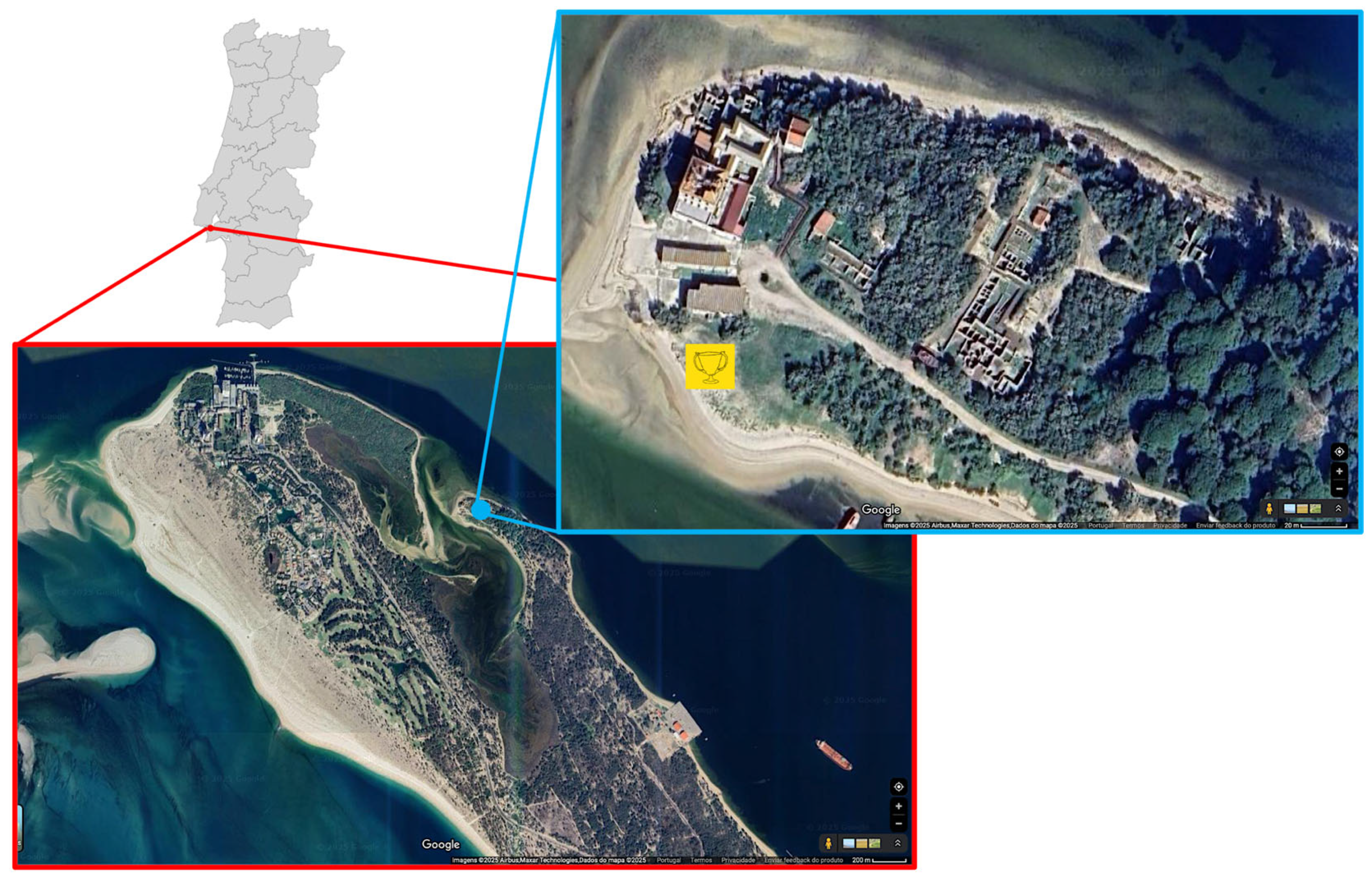
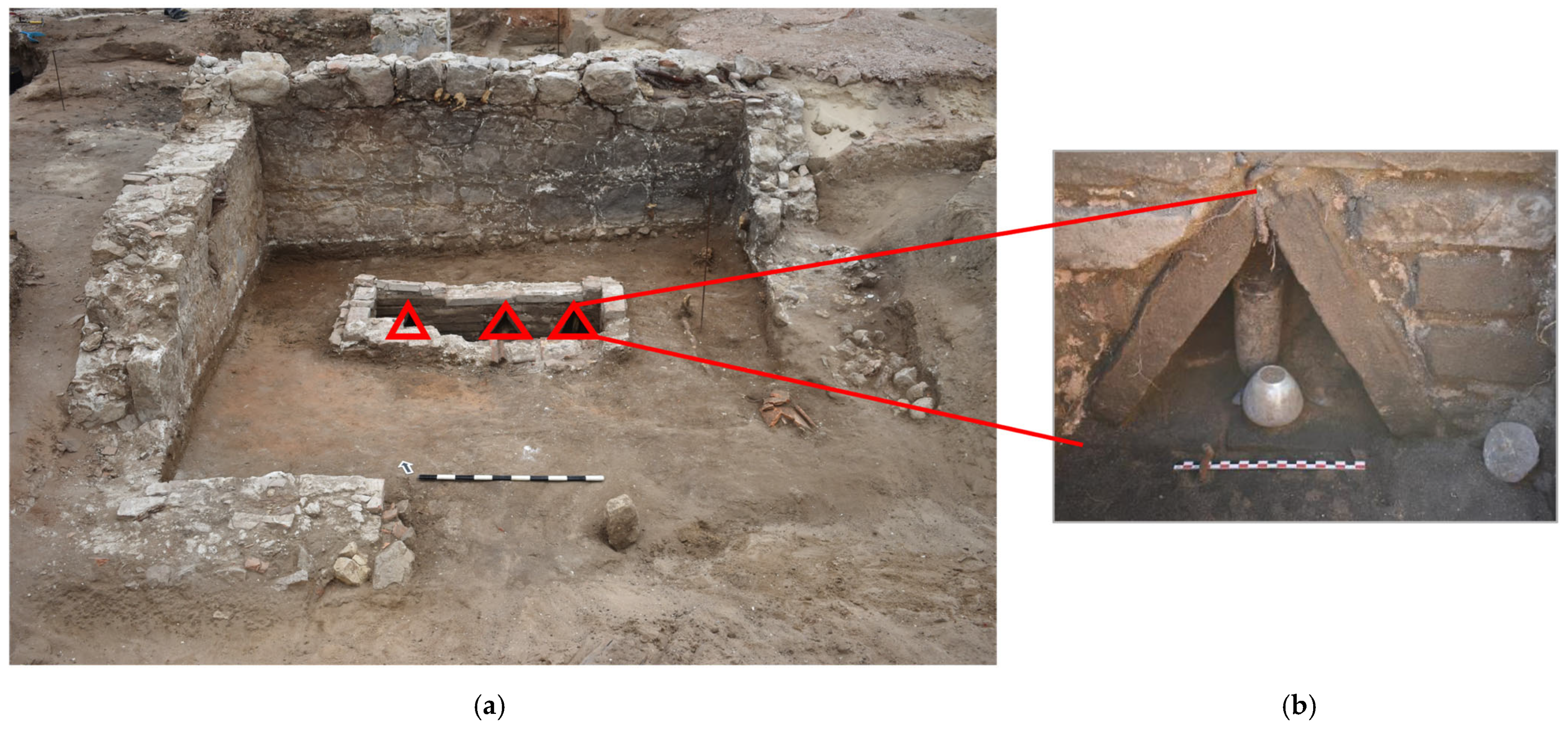

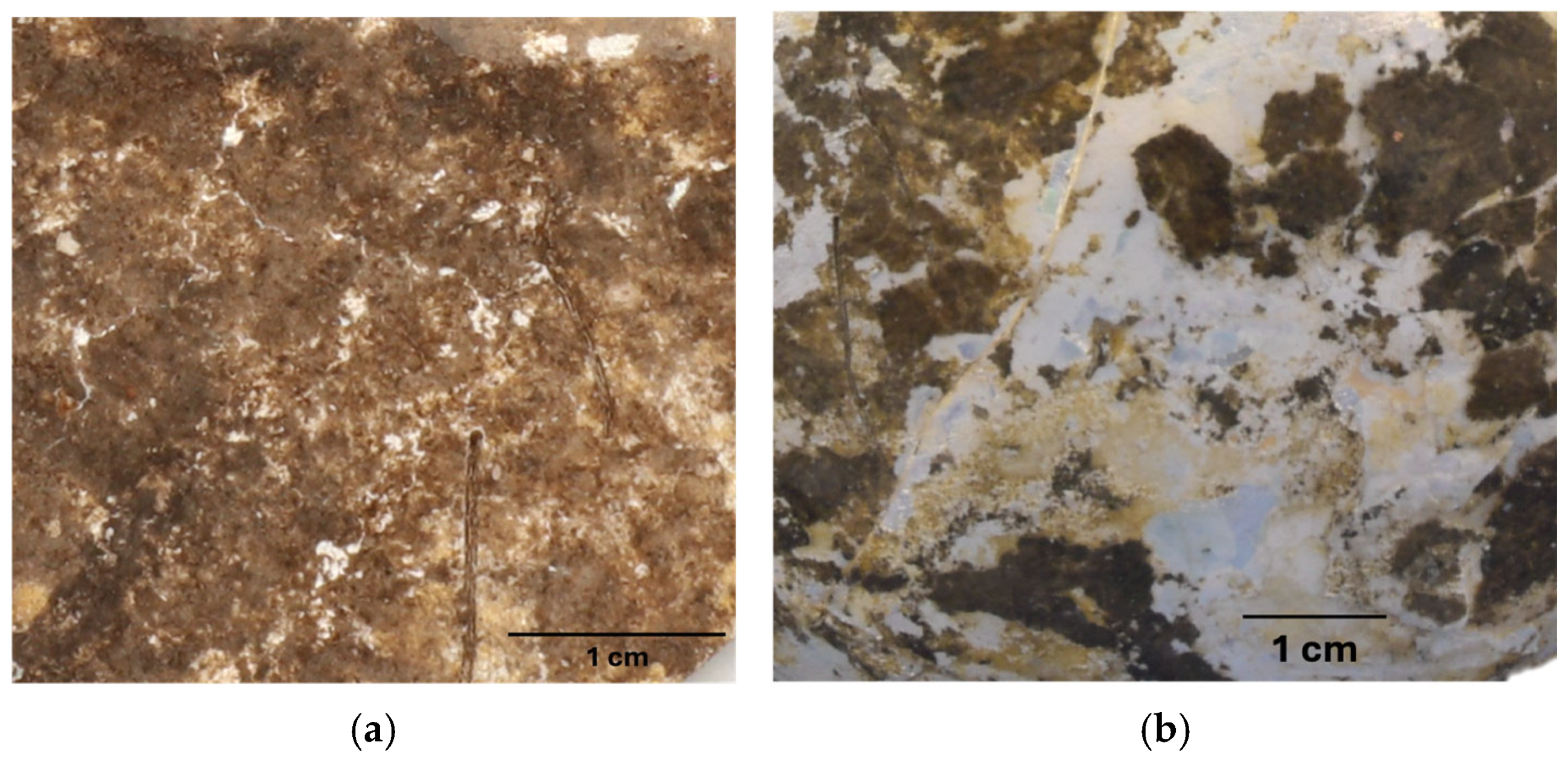

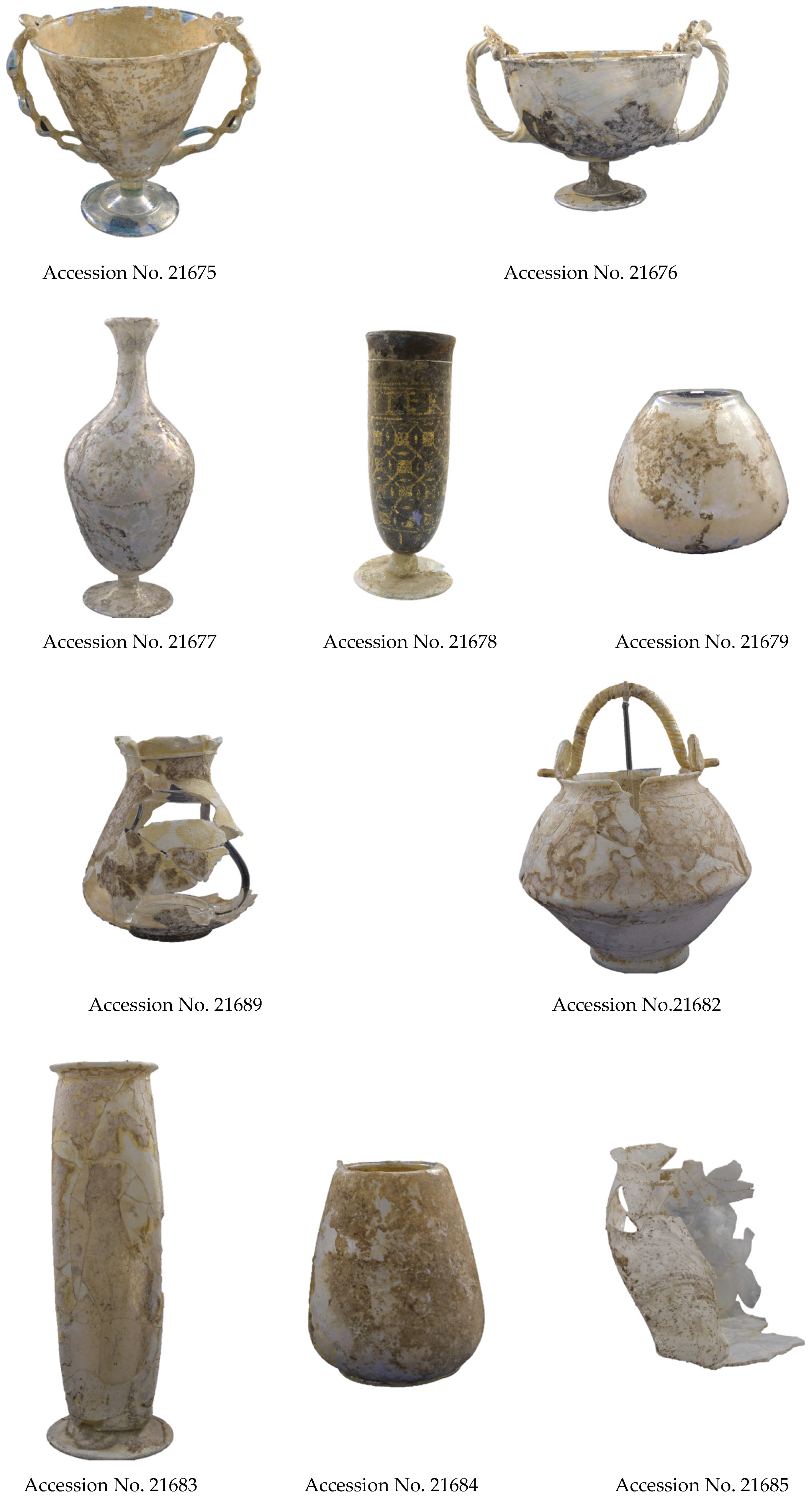
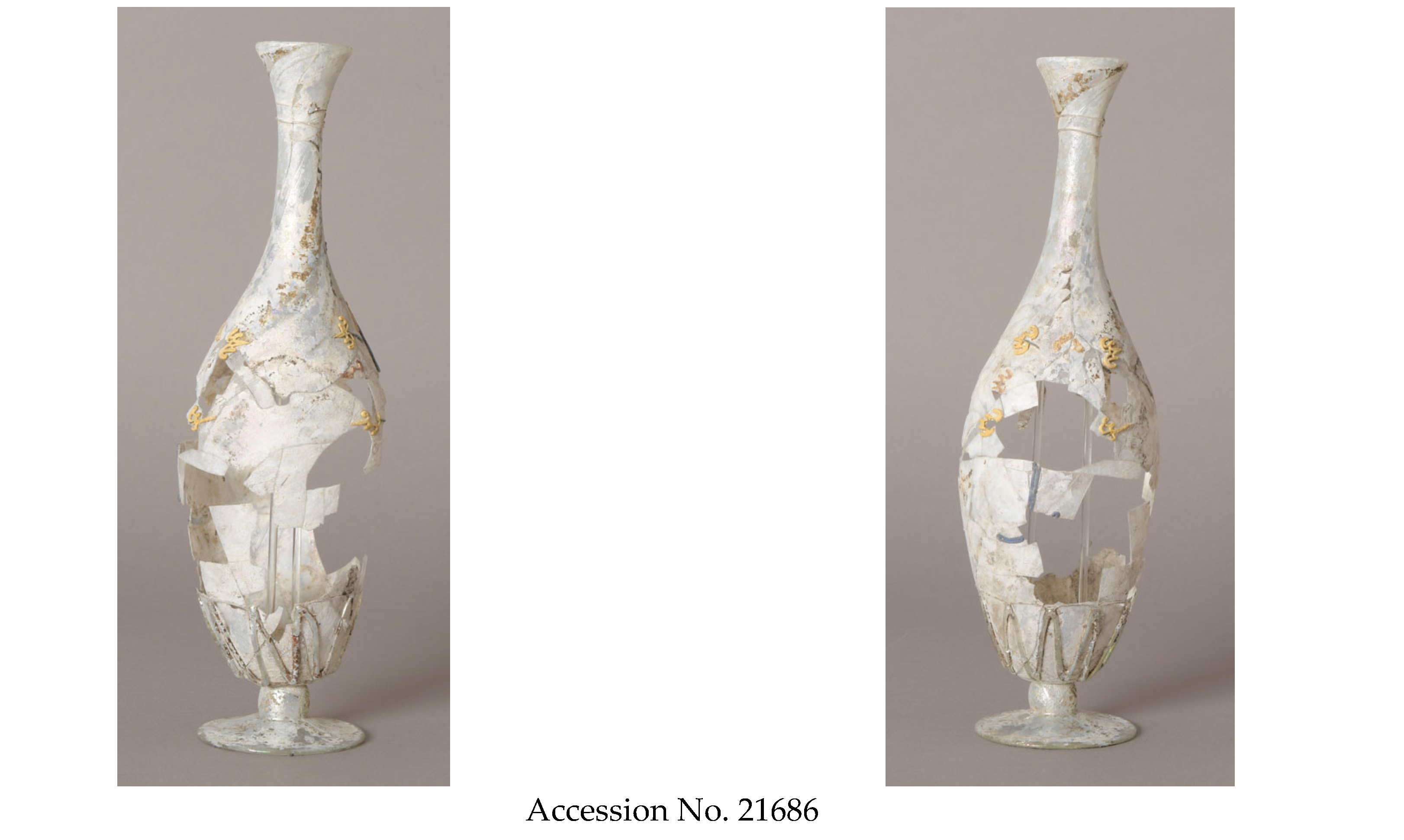
| Photos of the Objects Before Intervention | Brief Description of the Typology |
|---|---|
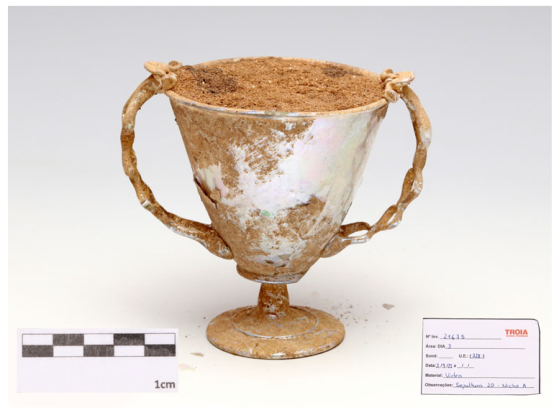 | Kantharos with inverted conical cup and a foot. Two applied chain handles. The foot has an applied trail (very thin), apparently using the same glass as the one used for the object. No pontil mark visible (probably polished). Blown glass, very thin, completely transparent and colourless. |
| Accession No. 21675 [10 cm height × 13 cm width] | |
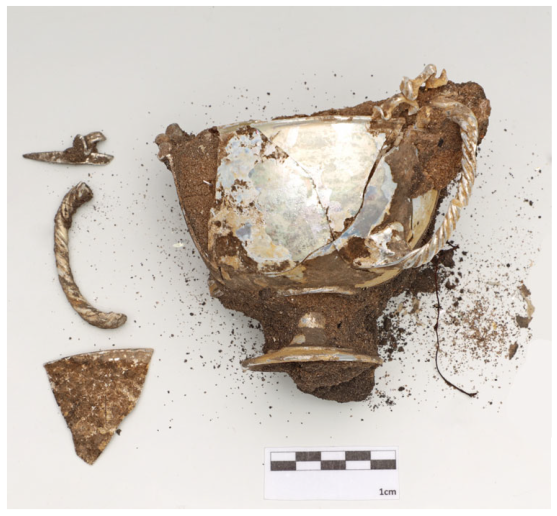 | Kantharos made with colourless glass. Bowl with two swing handles on stem with hollow conical foot. The cup has an out-turned thin lip, with a thin vertical wall and rounded bottom with an applied single concentric trail. The two swing handles are placed on opposite sides of the body and go from the top of the rim to the bottom of the bowl. The top of the handles is decorated with three superimposed threads of different sizes worked almost as festoons. The stem is short, solid, and cylindrical, and it has an applied hollow conical foot with a single concentric trail on the upper surface and round edge and no pontil mark visible (possibly polished). |
| Accession No. 21676 [9 cm height × 9 cm width] | |
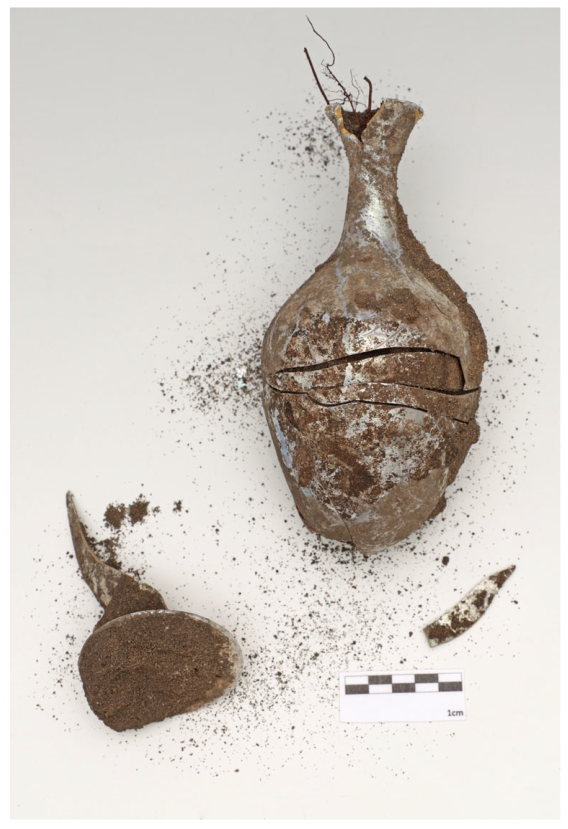 | Flask with a blown rounded rim; neck flaring to rim and to an inverted conical body. The object seems to be undecorated. The foot is attached to the object with a round solid knop. |
| Accession No. 21677 [19.5 cm height × 9 cm width] | |
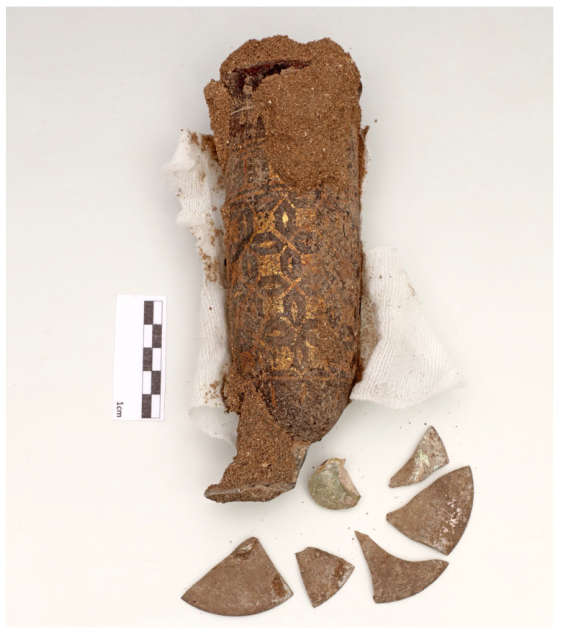 | Tall beaker with long cylindrical body that tapers to a rounded bottom with a solid stem shaped as a sphere and a foot with pontil mark. Body is made in purple coloured glass (and the foot is on colourless transparent glass). The body of the beaker is gilded with a geometric pattern of lozenges with squares in the middle (resembles a geometric pattern from architecture). On the top, close to the rim, it has a Latin inscription VTERE. FELICITER. (Use Happily)1. It has a thin string in opaque white glass applied below the rim. Below the rim it is possible to perceive an inscription. |
| Accession No. 21678 [15.7 cm height × 7 cm width] | |
 | Small beaker or cup, blown and made with colourless glass. It has a pear-shaped body with a round lip. The base is almost flat with a concentric or circular applied ring foot with the pontil mark in the centre. |
| Accession No. 21679 [5.5 cm height × 6.7 cm width] | |
 | Set of fragments of colourless glass, initially thought to be part of one of the other more complete objects. After conservation, it revealed to be a small beaker or cup with a pear-shaped body and a narrow neck. The body is wider at the base and the upper part tapers before flaring out to form a rim with a thickened and rounded rim. It has a concave base where an applied ring foot is visible. At the centre a pontil mark can be perceived. The decoration was made by applying two colourless threads, one below the rim and the other close to the base of the object. |
| Accession No. 21680 [7.3 cm height × 6 cm width] | |
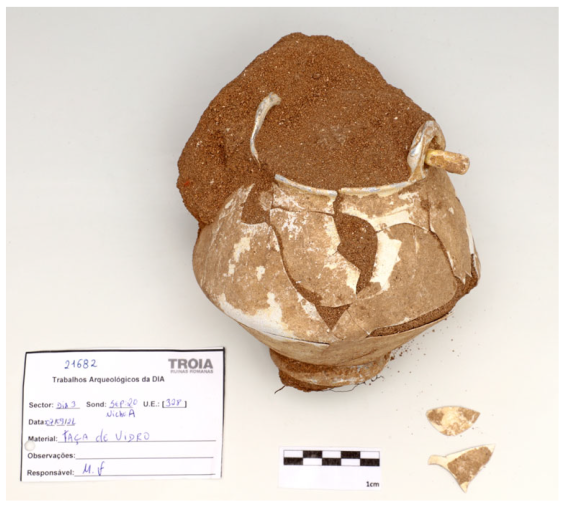 | Bucket-shaped bowl with swing handle. The rim is rounded and out curved. The body has a biconical shape and the base is composed by a folded ring. Two circular suspension ring handles are applied to the rim to hold the handle that is shaped like an arch and is twisted. It is simply decorated with two applied glass threads, one close to the rim and the other close to the base. |
| Accession No. 21682 [16 cm height × 13.5 cm width] | |
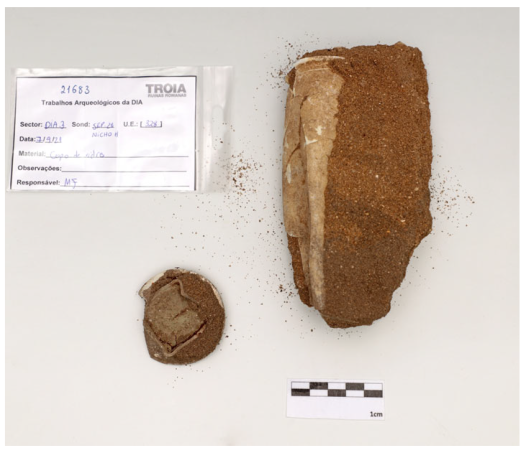 | Flask with a cylindrical shape made with colourless transparent glass. The body has four vertical deep indentations of unequal length and depth, and a very thin applied trail below the rim is the only decoration. The base is made by a foot with a truncated-conical shape and has a discrete pontil mark in the centre. |
| Accession No. 21683 [14.5 cm height × 4 cm width] | |
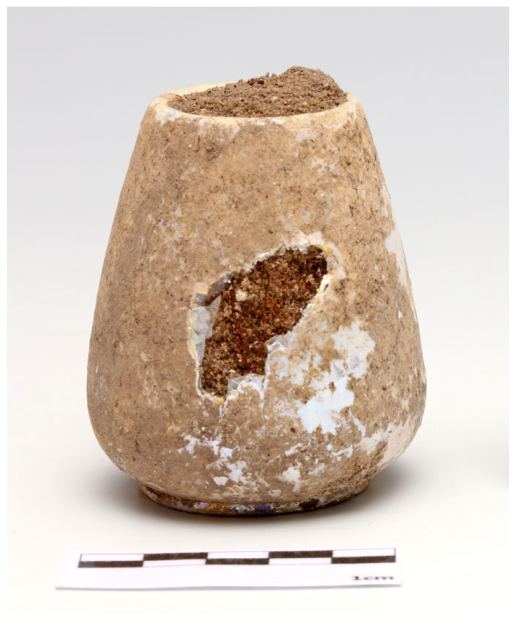 | Smal beaker or cup made with blown colourless glass. It has a pear-shaped body with a round lip. The base is almost flat with a concentric or circular applied ring foot with the pontil mark in the centre. |
| Accession No. 21684 [6 cm height × 5.5 cm width] | |
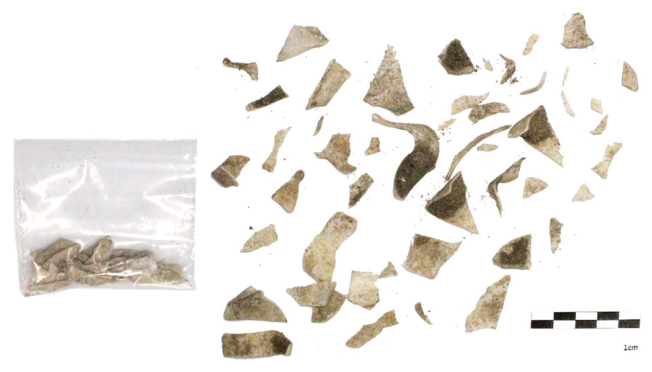 | Set of fragments of colourless glass, initially thought to be part of one of the other more complete objects. Small footless beaker or cup made with blown colourless glass. It has a wide truncated conical body that surpasses its hight. The object has four deep indentations as decoration, plus a thin glass threat just below the rim. The base is flat, and the rim seems to be cut and left unpolished. |
| Accession No. 21685 [6.5 cm height × 8.5 cm width] | |
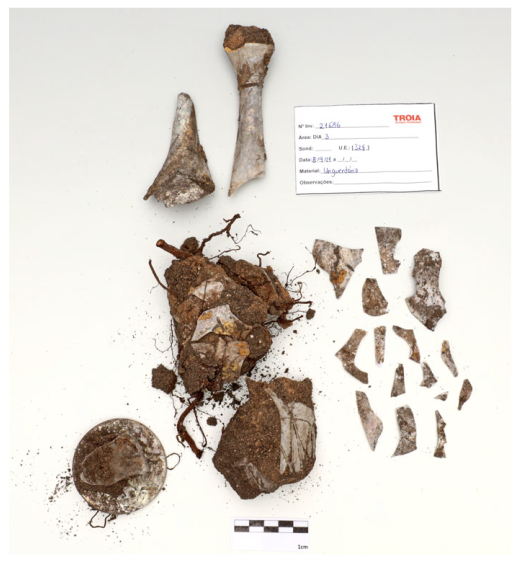 | Flask made with a colourless glass has a body with a spindle shape, supported by a baluster-shaped stem and a discoid foot with a pontil mark at centre. The neck is thin and elongated with a cylindrical shape and flares out to a round rim. The decoration of the object is made by an intricate application of colourless (base and rim) and coloured (body) glass threads. The central part of the body is decorated with yellow, red, and blue threads following a floral motif. |
| Accession No. 21686 [25 cm height × 7 cm width] |
| Step | Solution/Material | Concentration/Preparation | Application/Number of Cycles |
|---|---|---|---|
| Dry Cleaning | Mechanical tools (brushes, dental tools) | N/A | Initial step, removed ~80% soil |
| Wet Cleaning | Distilled water | Pure | Single or multiple applications to remove adhered soil |
| Chemical Cleaning | Nitric acid | 3% and 6% | Applied with brush, left for 2–3 s, rinsed with distilled water, repeated 4–5 times |
| Consolidation | Paraloid® B-72 | 5–10% in acetone | Applied under magnification to flaking areas. Each flaking area was consolidated once, and its effectiveness was visually inspected after. Whenever necessary, a second application was performed. |
| Adhesive | Paraloid® B-72 + fumed silica | ~50% in acetone | Applied to break edges using aluminium tubes. |
| Join Reinforcement | Japanese paper + PB-72 | 10% PB-72 in acetone | Applied internally on 3 vessels (21680, 21682, 21686) |
Disclaimer/Publisher’s Note: The statements, opinions and data contained in all publications are solely those of the individual author(s) and contributor(s) and not of MDPI and/or the editor(s). MDPI and/or the editor(s) disclaim responsibility for any injury to people or property resulting from any ideas, methods, instructions or products referred to in the content. |
© 2025 by the authors. Licensee MDPI, Basel, Switzerland. This article is an open access article distributed under the terms and conditions of the Creative Commons Attribution (CC BY) license (https://creativecommons.org/licenses/by/4.0/).
Share and Cite
Coutinho, I.; Borges, B.; Koob, S. An Archaeological Challenge: The Conservation and Restoration of Luxury Roman Glass from Troia, Portugal. Heritage 2025, 8, 209. https://doi.org/10.3390/heritage8060209
Coutinho I, Borges B, Koob S. An Archaeological Challenge: The Conservation and Restoration of Luxury Roman Glass from Troia, Portugal. Heritage. 2025; 8(6):209. https://doi.org/10.3390/heritage8060209
Chicago/Turabian StyleCoutinho, Inês, Beatriz Borges, and Stephen Koob. 2025. "An Archaeological Challenge: The Conservation and Restoration of Luxury Roman Glass from Troia, Portugal" Heritage 8, no. 6: 209. https://doi.org/10.3390/heritage8060209
APA StyleCoutinho, I., Borges, B., & Koob, S. (2025). An Archaeological Challenge: The Conservation and Restoration of Luxury Roman Glass from Troia, Portugal. Heritage, 8(6), 209. https://doi.org/10.3390/heritage8060209







